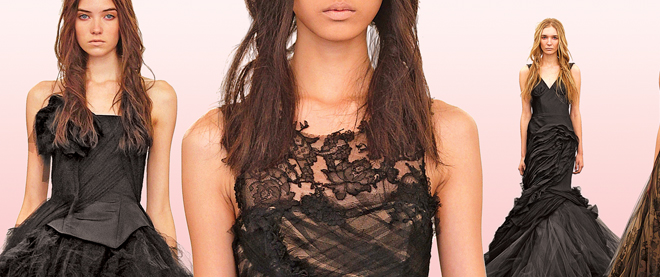The black wedding gown backlash
Despite the lack of choice, brides are happy not stepping outside the white dress box
Peter Michael Dills/Getty Images/Photo Illustration by Lauren Cattermole
Share

Last October, designer Vera Wang, fairy godmother to the wedding industrial complex, lobbed a neutron bomb into that white-lace vortex when she showed black at New York’s 2012 bridal fashion week. And not just one black dress, like some malevolent dark swan stalking the joint. Wang made black—dramatic confections of tulle, lace and organza—the theme of her collection. In an industry propelled by conformity and “tradition,” the display was shocking, even potentially seismic. Queen Victoria may have popularized the white-as-driven-snow dress at her 1840 wedding, but Wang parlayed strapless, princessy ivory dresses costing four figures and up into a $100-million-plus empire. But, after two decades, ennui had set in, Wang told the New York Times. She wanted to “step outside the box”; black felt “fresh and tongue-in-cheek,” she said. “For me, it helped build a sense of mystery that I was hungry for. And it added this sensuality and sexuality, and a little bit of severity, too.”
The move was shrewd; it grabbed attention, and targeted older and second-time brides who don’t want to look like fantasy virgin princesses. Yet retailers are skeptical brides will chuck the white uniform. Eleanore Rosenstein, who operates Toronto’s Vera Wang boutique, ordered a half-dozen black dresses due to arrive any day. She doesn’t expect them to fly out the door. “Brides are traditional,” she says. Demand for colour—lavender, pistachio and blush—is limited, she says, pointing to a $4,000 violet gown: “It’s gorgeous, but more of a red-carpet look.” White is a “look-at-me” hue—it’s fresh. “Could Kate Middleton have walked down the aisle in black?” she asks. Black for the bride will fuel bridesmaids’ hell, she says: “What will they wear? White?” It also means no veil—unless a bride wants to look like she’s mourning the end of her independence.
Molly Guy, owner of Stone Fox Bride, an “anti-bridal showroom” in New York City, is doubtful black will catch on. It’s not unique enough for her high-fashion clientele, she says: “Everyone has a black dress.” She’s seeing coloured dresses, noting a friend recently married in purple: “She was stunning.” Yet white is a mainstay, Guy believes, recalling shopping for her 2010 wedding: “There’s this visceral gut feeling of excitement that comes from seeing a bunch of white dresses next to each other; it’s special.” She bought a red and pink Alexander McQueen gown, then changed her mind and wore a white Alice by Temperley dress. “There’s something really beautiful and pure about getting married in white,” she says. “And I’m not someone who cares in the least about things like that.” Brides want to wear something that hints at a wedding dress and bridal tradition, she believes: “Chances are your mom got married in white, and your grandmother.”
Brooklyn, N.Y.-based filmmaker Therese Shechter was momentarily sucked into white-dress frenzy while filming herself trying them on for her documentary about virginity, How to Lose Your Virginity. “After trying on five or six dresses, I was in this weird place, like ‘This is really, really pretty,’ ” the Toronto native says. But she rejected the purity symbolism for her own wedding in 2010, choosing a green gown with an overlay of black netting. “A lot of women love the idea of the white wedding and becoming this princess for a day,” Shechter says. “But for me, it smacks of advertising some kind of sexual status that my groom didn’t have to do.” “Re-virginizing” for a day didn’t appeal, she says with a laugh: “My sexual history is one of the good things I bring to this marriage.”
Marking the occasion with “very special clothing” was important to her, and she wishes women felt freer to reflect themselves fully at their weddings. “The industry sets up this template and you have to fit yourself into it, and they trick you by giving you different sleeve lengths or white and ecru. But it’s a narrow range of choices.” And now we can add black to those choices. Or can we? If early backlash is any indication, Wang may have found it “fun to step out of the box,” as she put it, but brides are happy to stay within it—which suggests the designer’s walk on the dark side was even witchier than it seemed.